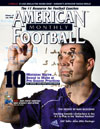AMERICAN FOOTBALL MONTHLY THE #1 RESOURCE FOR FOOTBALL COACHES
Article CategoriesAFM Magazine
|
Matching Leverage with Leverage Against the Spread OffenseTeaching outside linebackers in the 4-3 to play in the \'walked position\'by: Mike Kuchar Senior Writer, American Football Monthly © More from this issue To the average football fan who turns on the television every weekend during the fall to watch their favorite team play, it may seem pretty obvious that there are a lot more skill positions on the field. They may recognize three and four wide receiver sets, the absence of a tight end and the QB lined up in a shotgun formation. If they are even somewhat studied in their knowledge of the game, they may even start to formulate conclusions on why these teams are getting more skill players on the field – to develop speed and create spacing, right? While that might all be true, as defensive coaches we must dig a little deeper to determine why spread offensive teams are doing what they are doing, and more importantly, what we can do to combat them. Perhaps no other position on the defensive side of the ball requires more responsibili....The full article can only be seen by subscribers. Subscribe today!
|
|
|||||||
| HOME |
MAGAZINE |
SUBSCRIBE | ONLINE COLUMNISTS | COACHING VIDEOS |
Copyright 2025, AmericanFootballMonthly.com
All Rights Reserved





